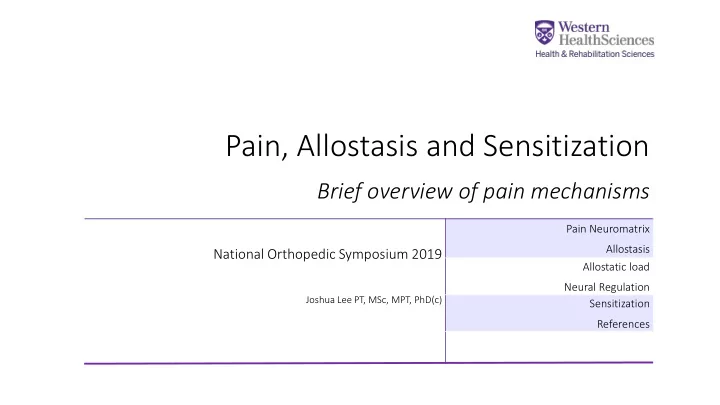

Pain, Allostasis and Sensitization Brief overview of pain mechanisms Pain Neuromatrix Allostasis National Orthopedic Symposium 2019 Allostatic load Neural Regulation Joshua Lee PT, MSc, MPT, PhD(c) Sensitization References
Pain Neuromatrix | Pain and Allostasis 1
Allostasis | Allo llostasis is – “Maintaining homeostasis through change” Process of adaptation to acute stress involving regulations in hormone levels and immune activation Allo llostatic Loa Load – “The price the body pays for being forced to adapt to adverse psychosocial or physical situations” Overall, cumulative burden placed on the individual Pain and Allostasis 2
Allostasis | Pain and Allostasis 3
Allostatic Load | Anxie iety, de depressio ion, , stress, s, PTSD, cognitive fog/impairment - (Epinephrine, norepinephrine, cortisol, BDNF) Chronic Chr ic inflammation – joint effusion + systemic challenge (cortisol) He Heart/Lung conditio ion (Systolic/diastolic BP, smoking, COPD, HTN, Arthritis, ILD, pulmonary HTN) Systemic condit itions – Ch Chole lesterol l (Serum HDL, total cholesterol, atherosclerosis), Diabetes (Glycosylated hemoglobin, blood sugar), Hor Di Hormonal condit itions (DHEA-S - HPA axis antagonist – dec. levels maladaptive, hysterectomy, endometriosis, prostate condition) y Gut microbiota (pain sensitivity, mood, systemic inflammation), ab abdominal gi girth (wais aist-to to-hip rati tio – inc. glucocorticoid activity, inc. adipose deposition), IBS IBS, di diet Bon Bone he health / hor hormonal level l – pain + deconditioning (Trauma, Menopause, BMD) Tis issue da damage/small join oint dam damage, Perip ipheral ne neuropathy, “smudging” effect (adverse posture/movement patterns, sensory ax – dermatomes/2pt discrim) Pain and Allostasis 4
Neural Regulation | Pain and Allostasis 5
Neural Regulation | From Scholtz and Woolf, Nature Neuroscience (2002) Pain and Allostasis 6
Neural Regulation | Inflammatory “soup” (blue box) can cause sensitization – increased activity / responsiveness in nerves. Peripheral sensitization (PNS – limbs) and Central sensitization (CNS – brain and spinal cord) From Scholtz and Woolf, Nature Neuroscience (2002) Pain and Allostasis 7
Neural Regulation | From Scholtz and Woolf, Nature Neuroscience (2002) Pain and Allostasis 8
Sensitization | Descending inhibitory control (PAG) Initial, sharp pain (A delta) Substance-P Dull, burning pain (C polymodal) WDR WDR Light touch (A beta) GABA interneurons Glial cells Allodynia + = Immune and endocrine mediators (cytokines, norepinephrine, peptides) Pain and Allostasis 9
Sensitization | • Occurs in the PNS and CNS • Occurs in three broad ways • Activ ivation-dependent (non-pathological) • “after - discharge” • Mod odulation of of ch channels ls (non-pathologic) • I.e. Removal of Mg 2+ block from NMDA channels (through activation of AMPA + Na influx) • Mod odification of of receptors (pathologic) • Increased sensitivity to stimuli • Increased density of receptor channels • Increased release of neurotransmitters Pain and Allostasis 10
Sensitization | Association between nociception, learning, memory, and reward Rational - Neo-cortex, pre-frontal cortex Emotional - Anterior Cingulate, anterior insula, pre-frontal, hippocampus, parahippocampus Instinctual - Nucleus Accumbens, Thalamus, Amygdala, Periaqueductal Grey matter Hy Hyperactiv ive – Primary somatosensory + motor (“smudging”), amygdala (fear), anterior insula (pain perception), thalamus (signal gain), parahippocampal gyrus (memory retrieval) Hypoactive – ventromedial PFC/orbitofrontal cortex (cognitive processing, emotion and Hy reward in decision making, executive function, functional attention), hippocampus (new memory encoding) Pain and Allostasis 11
References | • Melzack R. Pain and the neuromatrix in the brain. Journal of dental education. 2001 Dec 1;65(12):1378-82. • McEwen BS. Allostasis and allostatic load: implications for neuropsychopharmacology. Neuropsychopharmacology. 2000 Feb 1;22(2):108-24. • Apkarian AV, Hashmi JA, Baliki MN. Pain and the brain: specificity and plasticity of the brain in clinical chronic pain. Pain. 2011 Mar;152(3 Suppl):S49. • Tracey I, Bushnell MC. How neuroimaging studies have challenged us to rethink: is chronic pain a disease?. The journal of pain. 2009 Nov 30;10(11):1113-20. • Tsao H, Galea MP, Hodges PW. Reorganization of the motor cortex is associated with postural control deficits in recurrent low back pain. Brain. 2008 Aug 1;131(8):2161- 71. • Janssen SA, Arntz A, Bouts S. Anxiety and pain: epinephrine-induced hyperalgesia and attentional influences. Pain. 1998 Jun 30;76(3):309-16. - A nxiety doesn’t necessarily influence pain, but attention does. Anxiety and distraction, showed different pain responses than anxiety and focusing on pain • Baron, Ralf. "Mechanisms of disease: neuropathic pain — a clinical perspective." Nature Reviews Neurology 2, no. 2 (2006): 95. • Kohno, Tatsuro, Haibin Wang, Fumimasa Amaya, Gary J. Brenner, Jen-Kun Cheng, Ru-Rong Ji, and Clifford J. Woolf. "Bradykinin enhances AMPA and NMDA receptor activity in spinal cord dorsal horn neurons by activating multiple kinases to produce pain hypersensitivity." Journal of Neuroscience 28, no. 17 (2008): 4533-4540. Pain and Allostasis 12
Recommend
More recommend